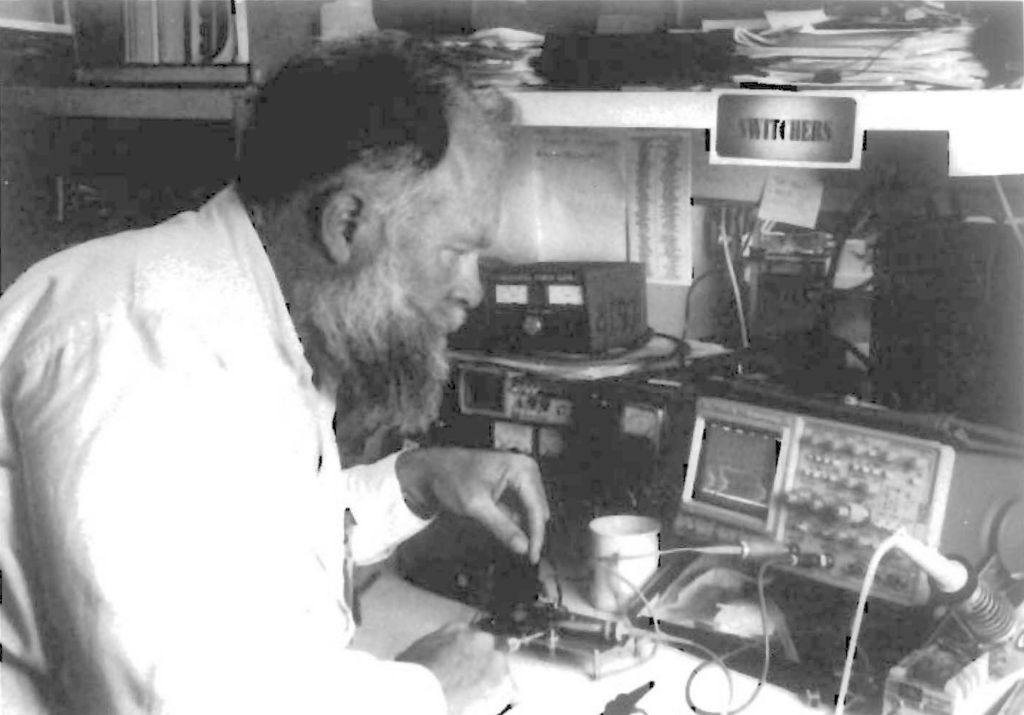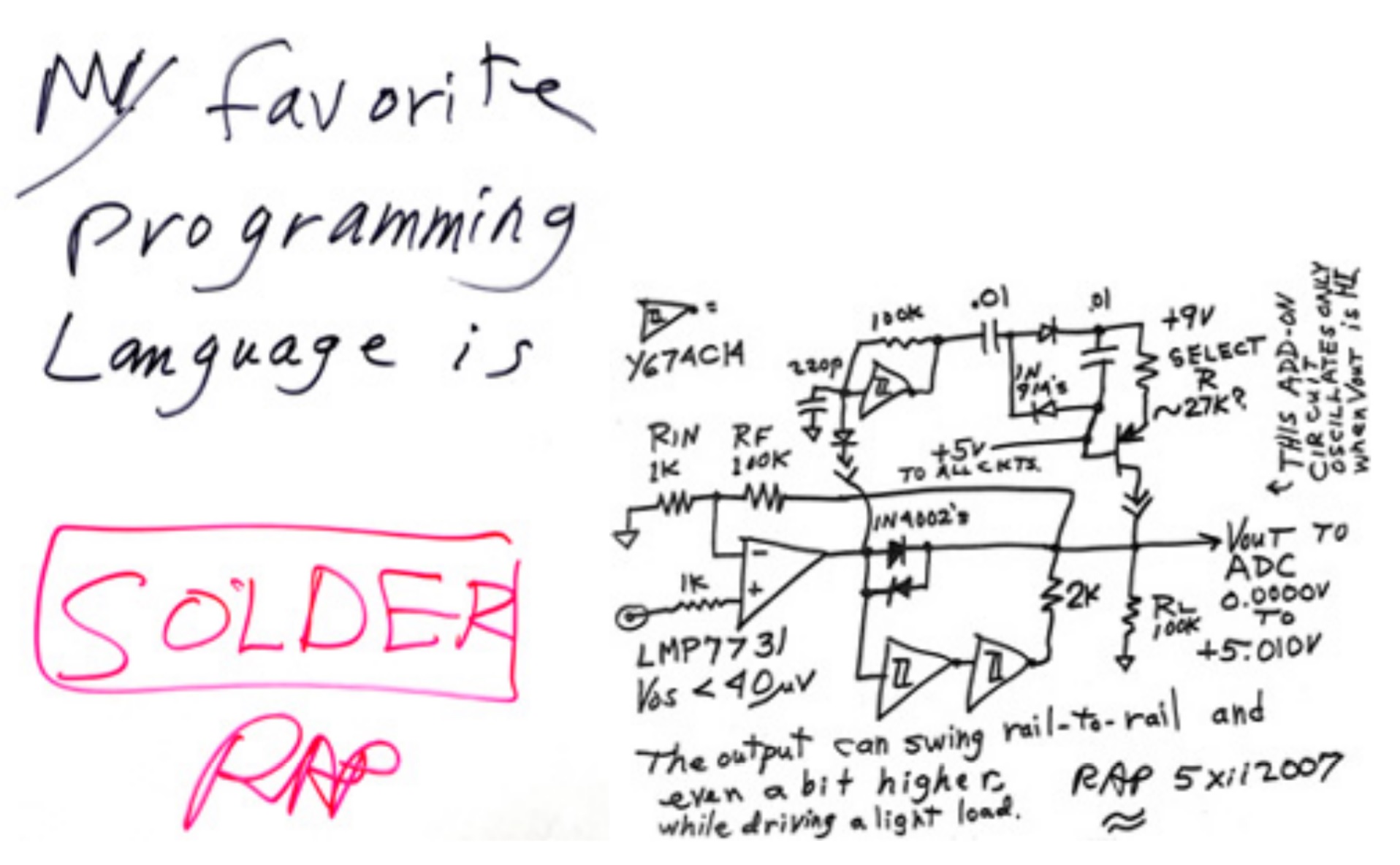
Categories
Statistics
Since 08.08.2014
Counts only, if "DNT = disabled".
Your IP is 18.191.223.123
ec2-18-191-223-123.us-east-2
Counts only, if "DNT = disabled".
Your IP is 18.191.223.123
ec2-18-191-223-123.us-east-2
Info
เราจะทำแบบวิศวกรผู้ยิ่งใหญ่

27. April 2024
Your valuable opinion :
Remembering_RAP.php 11043 Bytes 23-04-2024 12:24:37
Remembering Robert A. Pease, aka "RAP"
Legendary Analog Expert

The Grandmaster at work
✈ East Coast Beginnings
After attending Northfield Mount Herman High School in Massachusetts, Bob earned a Bachelor of Science degree in
electrical engineering from MIT in 1961 and started working at George A. Philbrick Researches. The Boston-based
company launched the commercial use of the operational amplifier in 1952. There Bob worked on affordable massproduced op amps using discrete solid-state components. He passed up an opportunity to work at nearby Analog
Devices and instead moved to the San Francisco Bay Area to work at National in 1976, which had rapidly become one
of the top three US semiconductor companies on the strength of its analog technology.
Among the semiconductor products Bob designed are temperature-voltage frequency converters used in
groundbreaking medical research expeditions to Mt. Everest in the 1980s. He also designed a seismic pre-amplifier
chip used to measure lunar ground tremors in the US Apollo moon landing missions. Among his more memorable
designs are the LM331 voltage to frequency converter and the LM337 adjustable voltage regulator.
"Bob Pease was one of those analog engineers who spanned the semiconductor industry's early history," said EDN
columnist Paul Rako, a former colleague. "He started working on vacuum tubes and discrete components, then
monolithic analog circuits with the planar process. Later in his career he put all of this accumulated knowledge to use
as an applications engineer. That's what gave him such breadth."
✈ Analog Seminars & Pease Porridge
Bob's reputation grew as he shared the secrets of analog design with engineers around the world via National's
Analog Seminars. Bob's passion for sharing information knew no bounds. He worked long hours from home as well as
at National answering phone calls and emails from anyone with questions about analog design: customers, students,
veteran engineers—it didn't matter.
"Discussing the solutions made one think differently and look at alternative possibilities," said strategic technologist
Don Archer. "It was a fun time working with Bob and he loved working through difficult problems to find elegant answers."
During his tenure, he began writing a continuing popular monthly column in Electronic Design magazine entitled
"Pease Porridge" about his experiences in the world of electronic design and application. Stories often started with his
trademark expression "What's All This [topic] Stuff, Anyhow?" He also wrote for EDN magazine for a time. He authored
eight books, his most popular being "Troubleshooting Analog Circuits." He also had his own his own website at
National.com with the subtitle, "What's All This Homepage Stuff, Anyhow?" (n.l.a.) where you can find
"several kinds of useful information" as well as Bob's passion for Nepal and its people.
✈ Analog by Design Show
Starting in 2003, Bob hosted the semiconductor industry's first online webcast tailored specifically for analog design
engineers. The "Analog By Design Show" was an engineering talk show by engineers for engineers. Early segments of
the half-hour talk show included co-hosts Paul Rako and Paul Grohe, plus a guest expert. As Bob's reputation grew and
he became a face of National, his persona grew as well. His image was featured in many promotions, often with a
humorous slant. Behind the humor, there was always a serious note around engineering excellence. As part of a
campaign to help engineers avoid repeating old mistakes in their new band gap reference circuits, Bob donned an
outlandish Czar of Band-Gaps uniform.
"Bob Pease goes back to the wild days of analog design," Rako said. "This is when a core group of passionate engineers and scientist would work hard, play hard, and do as they pleased."
"Bob Pease goes back to the wild days of analog design," Rako said. "This is when a core group of passionate engineers and scientist would work hard, play hard, and do as they pleased."

✈ The Right Stuff
Recently Bob was working on material called "How to Choose an Op Amp" featuring sage advice and his inimitable
style. He was also updating the popular application note, AN-31,
a collection of op amp circuits dating back 1969. He was in the process of writing about the history and evolution of these circuits and the best
ways to implement these circuits using today's op amps.
Bob received many awards for his work, including the Lifetime Achievement Award from the Embedded Systems Conference (2010) and Electronic Design magazine's Electronic Engineering Hall of Fame (2002). He was listed as one of the top 10 analog engineers of all time in a 2009 EE Times story. TI Fellow Dennis Monticelli remembers Bob as a helpful colleague and friend. "We go way back to my days as a green engineer when his gregarious personality and sheer knowledge drew me in. Bob was always generous with his time and never forgot what interested you whether work-related or not. He could multi-task like no other, yet also dive deep and narrow into esoteric areas. While famous for his analog expertise and passion for seat-of-the-pants engineering, his interests were actually quite broad and he would gladly engage on a wide variety of subjects. I will miss him yet take solace in the fact that his legacy lives on in the hearts and minds of true analog engineers everywhere." "The industry has lost an analog giant," said former National CEO Don Macleod. "Bob Pease was an extraordinarily talented engineer who cared deeply that others gained the knowledge they needed to advance their own work. He was a spokesperson for us for many years, with a worldwide following." Bob Pease is a hero of the analog world. We will miss him greatly.
Bob received many awards for his work, including the Lifetime Achievement Award from the Embedded Systems Conference (2010) and Electronic Design magazine's Electronic Engineering Hall of Fame (2002). He was listed as one of the top 10 analog engineers of all time in a 2009 EE Times story. TI Fellow Dennis Monticelli remembers Bob as a helpful colleague and friend. "We go way back to my days as a green engineer when his gregarious personality and sheer knowledge drew me in. Bob was always generous with his time and never forgot what interested you whether work-related or not. He could multi-task like no other, yet also dive deep and narrow into esoteric areas. While famous for his analog expertise and passion for seat-of-the-pants engineering, his interests were actually quite broad and he would gladly engage on a wide variety of subjects. I will miss him yet take solace in the fact that his legacy lives on in the hearts and minds of true analog engineers everywhere." "The industry has lost an analog giant," said former National CEO Don Macleod. "Bob Pease was an extraordinarily talented engineer who cared deeply that others gained the knowledge they needed to advance their own work. He was a spokesperson for us for many years, with a worldwide following." Bob Pease is a hero of the analog world. We will miss him greatly.
✈ Bob's Stuff
• The Best of Bob Pease Website : click here.
• Bob Pease Labnotes 2005 : click here.
• Troubleshooting Analog Circuits : available at Amazon.
• Bob Pease Labnotes 2005 : click here.
• Troubleshooting Analog Circuits : available at Amazon.
✈ Charity
Bob supported the Nepal Youth Foundation,
helping Nepalese children live better lives.
✈ Credits
This is mainly a copy of my colleague Thomas Schaerer.
Original here.
✈ Share your thoughts
The webmaster does not read these comments regularely. Urgent questions should be send via email.
Ads or links to completely uncorrelated things will be removed.
Your Browser says that you allow tracking. Mayst we suggest that you check that DNT thing ?
 ช้างเผือก
ช้างเผือก
